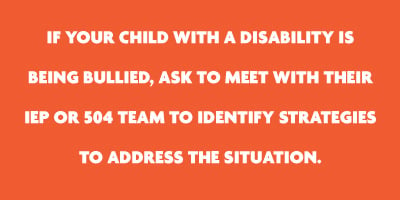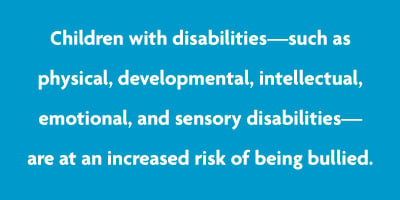Students with Disabilities
5 Important Facts
Top five things for parents, educators, and students to know1. The impact – Bullying affects a student’s ability to learn
Many students with disabilities are already addressing unique challenges in school. When they are bullied, it can directly impact their ability to learn and grow. Bullying is not a harmless rite of childhood that everyone experiences. Research shows that bullying can negatively impact a child’s access to education and lead to:- School avoidance and higher rates of absenteeism
- Lower grades
- Inability to concentrate
- Loss of interest in academic achievement
- Increase in dropout rates
Although only ten U.S. studies have been conducted on the connection between bullying and developmental disabilities, all of these studies found that children with disabilities were two to three times more likely to be bullied than their nondisabled peers. (Disabilities: Insights from Across Fields and Around the World; Marshall, Kendall, Banks & Gover (Eds.), 2009.)
2. The definition – Bullying based on a student’s disability may be considered harassment
The Office for Civil Rights (OCR) and the Department of Justice (DOJ) have stated that bullying may also be considered harassment when it is based on a student’s race, color, national origin, sex, disability, or religion.
Harassing behaviors may include:
- Unwelcome conduct, such as verbal abuse, name calling, epithets, or slurs
- Graphic or written statements
- Threats
- Physical assault
- Other conduct that may be physically threatening, harmful, or humiliating
3. Advocating for yourself and others has a significant impact
Parents, educators, community members, and students all have an important advocacy role to play in preventing and addressing bullying.
Advocacy
Providing support for students who are being bullied, are vulnerable to being hurt or harmed, or are isolated from other students.
Self-Advocacy
Speaking up for yourself, communicating what you need, and taking action.
Talk with youth about bullying
It is important that adults understand how to communicate with youth about a bullying situation. Some children have an easier time talking to adults about personal matters and may be willing to discuss bullying. Others may be reluctant to share information about the situation. There could be a number of reasons for this: the student bullying them may have told them not to tell or they might fear that telling someone will make matters worse. When preparing to talk to children about bullying, adults should consider how they will handle the child’s questions and emotions and what their own responses will be. Adults should be prepared to listen without judgment, providing the child with a safe place to work out their feelings and determine next steps. For more information read, Help Your Child Recognize the Signs of Bullying .Adult intervention is important
It is never the responsibility of the child to fix a bullying situation. If children could do that, they wouldn’t be seeking the help of an adult in the first place.
Peer to peer advocacy—Supporting and educating youth as advocates
Most students don’t like to see bullying, but they may not know what to do when it happens. Peer advocacy—students speaking out on behalf of each other—is a unique approach that empowers students to protect those targeted by bullying.
Peer advocacy works for two reasons. First, students are more likely than adults to see what is happening with their peers and this influence is powerful. Second, a student telling someone to stop bullying has much more impact than an adult giving the same advice.
For more information, visit the Peer Advocacy tab.
Self-advocacy – The importance of involving youth in decision making and planning
Self-advocacy means that the youth experiencing bullying is able to communicate what they want and need in a straightforward way.
Self-advocacy is knowing how to:
- speak up for yourself
- Describe your strengths, challenges, needs, and wishes
- Take responsibility for yourself
- Learn about your rights
- Obtain help or know who to ask if you have a question
The person who has been bullied should be involved in deciding how to respond to the bullying. This participation can provide students with a sense of control over their situation, and help them identify someone who is willing to listen, take action on their behalf, and reassure them that their opinions and ideas are important.
For more information, visit the Self-advocacy tab.
The Student Action Plan Against Bullying is a self-advocacy resource. It includes three simple steps to explore specific, tangible actions to address bullying:
- Define your experience
- Reflect on your ideas
- Develop potential solutions
Download the Parent and Educator Guide to Using the Student Action Plan Against Bullying
4. Law and policy – There are legal protections and provisions for students with disabilities who are being harassed
Federal
As a parent of a student with disabilities, it’s important to know the federal laws and resources specifically designed for your child’s situation. Parents have legal rights when their child with a disability is the target of bullying or harassment related to their disability. According to a 2000 Dear Colleague Letter from the Office of Civil Rights, “States and school districts also have a responsibility […] to ensure that a free appropriate public education (FAPE) is made available to eligible students with disabilities. Disability harassment may result in a denial of FAPE under these statutes.” Under these federal laws, schools are required to respond to harassment or bullying of a student with a disability. The school must provide immediate and appropriate action to investigate, communicate with targeted students regarding steps to end harassment, eliminate any hostile environment, and prevent harassment from recurring. If the school is not taking necessary action, parents may consider filing a formal grievance with the Office of Civil Rights. For more information, visit the Rights and Policies tab.State
In addition to the federal laws, all states have laws that address bullying. Some have information specific to students with disabilities. Many school districts also have individual policies that address how to respond to bullying situations. Contact your local district to request a written copy of the district policy on bullying. For a complete overview of state laws, visit StopBullying.gov.5. The resources – Students with disabilities have resources that are specifically designed for their situation
Individualized Education Program (IEP)
Students with disabilities who are eligible for special education under the Individuals with Disabilities Education Act (IDEA) will have an Individualized Education Program (IEP) or a 504 Plan. The IEP or 504 Plan can be a helpful tool as part of a bullying prevention plan. Remember, every child receiving special education is entitled to a free appropriate public education (FAPE) and bullying can become an obstacle to that education. For more information, visit Bullying Prevention for Children with Disabilities: Using the IEP, 504 Plan, or Creating Your Own PlanDear Colleague Letters
A 2014 Dear Colleague letter from the Office for Civil Rights states that bullying of any kind, not just on the basis of a student’s disability, may result in a violation of FAPE, and reiterates schools’ responsibility to address behavior that may result in disability-based harassment or violations of FAPE. For more information, visit the Rights and Policies tab.Template Letters
Parents may use one of these template letters as a guide for writing a letter to their child’s school. These letters contain standard language and “fill-in-the-blank” spaces so that the letter can be customized for a child’s specific situation.- Version for a Student with a 504 Plan
- Version for a Student with an IEP Plan
- It will alert school administration of the bullying and your desire for interventions
- It can become your written record when referring to events. The record (letter) should be factual and absent of opinions or emotional statements.
Rights and Policies
Bullying based on a student’s disability may be considered harassment.
The Office for Civil Rights (OCR) and the U.S. Department of Justice (DOJ) have stated that bullying may also be considered harassment when it is based on a student’s race, color, national origin, sex, or disability.
Harassing behaviors may include:
- unwelcome conduct, including verbal abuse such as name-calling, epithets, or slurs
- graphic or written statements
- threats
- physical assault
- other conduct that may be physically threatening, harmful, or humiliating
When does bullying reach the threshold of disability harassment and meet the criteria for federal protection?
According to the OCR and the DOJ, bullying may also be considered harassment when the conduct is sufficiently serious that it interferes with (or limits) a student’s ability to participate in (or benefit from) the services, activities, or opportunities offered by a school, and it is based on a student’s disability.
Federal Laws that Apply to Disability Harassment
Parents have legal rights when their child with a disability is the target of bullying or disability harassment.
Federal Laws: Section 504 of the Rehabilitation Act of 1973 (often referred to as ‘Section 504’) and Title II of the Americans with Disabilities Act of 1990 (Title II). Section 504 covers all schools, school districts, colleges, and universities receiving federal funds. Title II covers all state and local entities, including school districts and public institutions of higher education, whether or not they receive federal funds.
What are they? These are federal laws that apply if the harassment denies a student with a disability an equal access or opportunity to a free appropriate public education (FAPE).
Who qualifies for these protections? Students who meet the Section 504/ADA definition of disability, including those with a record of or who are regarding as having a disability, qualify for these protections. This includes students with a 504 Plan or IEP, but does not exclude students with disabilities not currently on a 504 Plan or IEP.
Who enforces these laws? The Office for Civil Rights (OCR) enforces Section 504 and Title II of the ADA.
There are legal protections and provisions for students with disabilities who are being harassed.
The Individuals with Disabilities Education Act (IDEA) is a federal law. It requires that each child who has a disability and qualifies for special education and related services must receive a free and appropriate public education (FAPE). The State Department of Education in each state enforces IDEA. Students with an Individualized Education Program (IEP) would qualify for these protections.
Section 504 of the Rehabilitation Act of 1973 (often referred to as “Section 504”) and Title II of the Americans with Disabilities Act of 1990 (Title II) are the federal laws that apply if the harassment denies a student with a disability an equal opportunity to education. The Office for Civil Rights (OCR) enforces Section 504 and Title II of the ADA. Students with a 504 plan or an IEP would qualify for these protections.
“Dear Colleague” Letters
A “Dear Colleague” letter is a guidance document issued by a federal agency that helps explain and interpret existing laws and regulations
In October 2014, as part of National Bullying Prevention Month, the U.S. Department of Education’s OCR issued a “Dear Colleague” letter with guidance to schools reminding them that bullying is wrong and must not be tolerated — including against America’s 6.5 million students with disabilities.
The Department issued guidance in the form of a letter to educators detailing public schools’ responsibilities under Section 504 of the Rehabilitation Act, Title II of Americans with Disabilities Act, and Individuals with Disabilities Act regarding the bullying of students with disabilities. If a student with a disability is being bullied, these federal laws require schools to take immediate and appropriate action to investigate the issue and, as necessary, take steps to stop the bullying and prevent it from recurring.
The letter further clarified that the bullying of a student with a disability on any basis, not just their disability, may result in a denial of FAPE that must be remedied by the school. Under Section 504, the IEP or 504 team should convene when bullying of a student with a disability occurs on any basis in order to determine whether the student’s needs have changed and whether FAPE is still being provided.
The letter also clarified that when OCR receives a complaint related to bullying of a student with a disability, it may investigate whether there has been a FAPE violation, a disability-based harassment violation, or both, depending on the unique circumstances of the case.
View the 2014 Dear Colleague Letter
Dear Colleague Letters Addressing Harassment
A 2013 Dear Colleague letter and enclosure by the Office of Special Education and Rehabilitative Services (OSERS) clarified that when the bullying of a student with a disability results in the student not receiving meaningful educational benefit under IDEA, the school must remedy the problem, regardless of whether the bullying was based on the student’s disability.
In 2010, another Dear Colleague letter from the OCR was issued that reminded school districts of their responsibilities under civil rights laws that prohibit discrimination and harassment on the basis of race, color, national origin, sex, disability, and religion.
In 2000, a Dear Colleague letter was sent to school districts nationwide from the U.S. Department of Education’s OCR and OSERS that defined the term “disability harassment.” The letter also explained that bullying based on disability may violate civil rights laws enforced by OCR as well as interfere with a student’s receipt of special education under the Individuals with Disabilities Education Act (IDEA).
The Role of Schools in Responding to Disability Harassment
When children are at school, their physical and emotional safety is the responsibility of school personnel. School districts have a legal responsibility to respond to disability harassment allegations.
As a parent, it’s important for you to know how the school is expected to respond to harassment. The following information provides a simple list of the school’s duties and possible responses. It is from the U.S. Office of Juvenile Justice and Delinquency Prevention webinar presentation, “Bullying, Harassment, and Civil Rights: An Overview of School Districts’ Federal Obligation to Respond to Harassment.”
Schools’ Duties
- Immediate and appropriate action to investigate or otherwise determine what happened.
- Inquiry must be prompt, thorough, and impartial. Interview targeted students, offending students, and witnesses, and maintain written documentation of investigation.
- Communicate with targeted students regarding steps taken to end harassment.
- Check in with targeted students to ensure that harassment has ceased.
When an investigation reveals that harassment has occurred, a school should take steps reasonably calculated to end the harassment including:
- Eliminate any hostile environment.
- Prevent harassment from recurring.
- Prevent retaliation against the targeted student(s) or complainant(s).
Possible Responses
- Develop, revise, and publicize policy prohibiting harassment and discrimination grievance procedures for students to file harassment complaints.
- Provide contact information for Title IX/Section 504/Title VI coordinators.
- Implement training for staff and administration on identifying and addressing harassment.
- Provide monitors or additional adult supervision in areas where harassment occurs.
- Discipline harassers.
- Limit interaction between harassers and targets.
- Provide counseling to harassed students or harassers.
- Provide harassed student an additional opportunity to obtain a benefit that was denied (e.g., retaking a test/class).
- Provide services to a student who was denied a benefit (e.g., academic support services).
- Publicize statements that the school will not tolerate harassment and will respond to any student who reports such conduct.
- Incorporate harassment awareness, and cultural tolerance training, into curriculum and other education programs for staff, students, and parents.
- Conduct school climate surveys.
- Involve parents and community groups in preventing future harassment.
Additionally, when the harassment involves a child with a disability, convene an IEP or 504 meeting to consider additional supports and services necessary to address the student’s provisions of FAPE (Free Appropriate Public Education).
Resources from Office for Civil Rights
- A fact sheet for parents on schools’ obligations under federal law to address bullying. The fact sheet is also available in Spanish .
- Seeking help from the Office for Civil Rights (OCR). The office investigates complaints of disability discrimination at schools. To learn more about federal civil rights laws or how to file a complaint, contact OCR at 800-421-3481 (TDD: 800-877-8339), or [email protected]. OCR’s website is www.ed.gov/ocr. To fill out a complaint form online, go to http://www.ed.gov/ocr/complaintintro.html.
- To view OCR’s guidance detailing public schools’ responsibilities regarding the bullying of students with disabilities in Spanish, click here .
Helpful Resources
Notifying the School About Bullying — Using a Template Letter
Parents should contact school staff each time their child informs them that he or she has been bullied. PACER Center has created template letters that parents may use as a guide for writing a letter to their child’s school. These letters contain standard language and “fill in the blank” spaces so the letter can be customized for your child’s situation.
- When the bullying is based on the child’s disability, federal laws can also apply under Section 504, Individuals with Disabilities Act (IDEA) and Americans with Disabilities Act Amendments Act of 2008 (ADAAA).
- Version for a Student with a 504 Plan (Word doc )
- Version for a Student with an IEP Plan (Word doc )
Data is important. Remember, if it is not in writing, it does not exist. Please be sure to keep a copy of the letter(s) for your records. These records can help parents keep a concise, accurate timeline of events. These sample letters are general in nature in order to serve all potential users.
View the “Notifying the School About Bullying” handout
Use Positive Strategies to Protect Your Child with Disabilities from Bullying
While any child can be a target of bullying, children with disabilities can be especially vulnerable. Although few studies exist concerning children with disabilities and bullying in the United States, the studies available indicate an increased risk for children with special needs. Parents can help protect their children with disabilities from bullying and its devastating effects if they promote effective strategies such as PACER’s Peer Advocacy Program, use the Individualized Education Program (IEP) as a tool, work with the school, and know their child’s rights under the law.
View the “Use Positive Strategies to Protect Your Child with Disabilities from Bullying” handout
Using the Individualized Education Program (IEP) or 504 Plan
Students with disabilities who are eligible for special education under the Individuals with Disabilities Education Act (IDEA) will have an Individualized Education Program (IEP). Students with disabilities may also be eligible for a 504 Plan.
If your child has an IEP or 504 Plan, it can be a helpful tool in a bullying prevention plan. Remember, every child on an IEP or 504 Plan is entitled to a free, appropriate public education (FAPE), and bullying can sometimes become an obstacle to receiving that education.
While the IEP or 504 Plan is a helpful tool, your child’s team is also an important resource to reach out to for support as a first step. The IEP or 504 team, which includes the parent, can identify strategies that may be written into the IEP to help stop the bullying. It may be helpful to involve your child, when appropriate, in the decision-making process. Such strategies include:
- Identifying an adult in the school who the child can report to or go to for assistance
- Determining how school staff will document and report incidents
- Allowing the child to leave class early to avoid hallway incidents
- Holding separate in-services for school staff and classroom peers to help them understand a child’s disability
- Educating peers about school district policies on bullying behavior
- Ensuring regular reassurance from the school staff to the student that he or she has a “right to be safe” and that the bullying is not his or her fault
- Shadowing of the student who has been bullied. School staff can shadow the student in hallways, classrooms, and playgrounds.
Using the IEP or 504 Plan to Help Address Bullying | PACERTalks About Bullying: Season 2, Episode 12
Individualized Education Program (IEP) or Section 504 plans can be helpful tools when creating a bullying prevention plan for students with disabilities. Rose Quintero, a PACER parent advocate, shares information about how to use an IEP or 504 plan to identify strategies to intervene and prevent bullying.
Student Action Plan Against Bullying
Are you an educator working with a student being bullied, a parent looking for ways to help your child change their behavior, or a student who wants to take action against bullying, but isn’t sure what to do?
As a student, bullying is something that impacts you, your peers, and your school — whether you’re the target of bullying, a witness, or the person who bullies. Bullying can end, but that won’t happen unless students, parents, and educators work together and take action.
The first step is to create a plan that works for you and your situation. This student action plan is an opportunity for you — either on your own or with your parents and teachers — to develop a strategy to change what’s happening to you or someone else. It’s your chance to make a difference.
To get started download the plan for students, along with the guide for adults.
Student Action Plan Against Bullying
Spanish Translation | Somali Translation | Hmong Translation
Parent and Educator Guide to Using the Student Action Plan Against Bullying
Spanish Translation | Somali Translation | Hmong Translation
Blog Post
Your ASD Child Being Bullied? Five Ways to Take Action
When your child is the target of bullying, your first response is often an emotional one, followed by wanting to act in the most effective, action-oriented way. This article published in Autism Parenting Magazine blog, March 2021, offers a few helpful suggestions.
Preventing bullying of students with disabilities: Four things parents and educators should know
Bullying can affect a student’s physical and emotional health, and it can interfere with a student’s right to receive an education. Posted to StopBullying.gov blog on October 17, 2016.
Self Advocacy
What does it mean to advocate for yourself?
Being your own advocate means that you ask for what you need while respecting the needs of others. For example, if you are at a store and a clerk ignores you, you are able to ask in a polite way to be served. Self-advocacy is asking for what you need in a direct, respectful manner. Why is this skill important? Self-advocacy helps you:- Obtain what is helpful for you
- Be involved in the decision-making process
- Learn to say “no” and be OK with it
- Respectfully express disagreement or differing opinion
- Help express your ideas to prevent any bullying you’re experiencing
Advocacy and Self-Advocacy | PACERTalks About Bullying, Episode 22
What does it mean to be an advocate for yourself as well as others, and how does that relate to bullying prevention?Student Action Plan Against Bullying
Ready to be a self-advocate to address bullying? Maybe not sure how to start? As a student, bullying is something that impacts you, your peers, and your school – whether you’re the target of bullying, a witness, or the person who bullies. Bullying can end, but that won’t happen unless students, parents, and educators work together and take action.
Start by creating a plan that works for you and your situation. This student action plan is an opportunity for you – either on your own or with your parents and teachers – to develop a strategy to change what’s happening to you or someone else. It’s your chance to make a difference.
The plan includes three steps:
- Step 1: Read through the examples on pages two and three of this Student Action Plan Against Bullying
- Step 2: Decide if you want to start this on your own or if you would like to involve an adult Note: Even if you start this on your own, it’s important to share with a trusted adult and provide them with information on the best way to support you. This is important because sometimes adults aren’t aware that the bullying is happening, and many bullying situations won’t get resolved until a caring adult is involved.
- Step 3: Complete the “My Personal Action Plan Against Bullying,” on page four with your own experience as a target of bullying, a witness, or the person who is bullying
Remember, if you are being bullied, it is not your fault. One of the most important steps you can take is to communicate what’s happening with an adult. Sharing what is happening and learning to advocate for yourself is important! By thinking through a plan you will have a voice in the solution.
To get started download the plan for students, along with the guide for adults.
Student Action Plan Against Bullying
Spanish Translation | Somali Translation | Hmong Translation
Parent and Educator Guide to Using the Student Action Plan Against Bullying
Spanish Translation | Somali Translation | Hmong Translation
Examples of Self Advocacy | PACERTalks About Bullying, Episode 25
In this video, Jody, director of PACER’s Parent Training and Information Center, shares a creative, real-life example to help visualize what self-advocacy using the “Student Action Plan” can look like in action.
Helpful Information for Middle and High School Students
Know Your Rights Every student has the right to be safe at school. Students have protections from bullying behavior through federal, state and local law and policies. Jamie’s Advice Whether you are being bullied, witnessing bullying, afraid of peer pressure, concerned your actions are hurting others, or something else, just ask her! With zero judgments and her best advice, Jamie will be there for you. Experiencing Bullying? Bullying affects everyone. Whether you’re the target, the bystander, or even the kid who picks on others, there’s something you can do to put an end to bullying.Helpful Information for Elementary School Students
If You See Bullying If you see bullying happen, you can help stop it. How? Speak up! When kids are willing to speak up about what they think is wrong, they can make a difference. If You Are Being Bullied Not sure what bullying is? Or if it’s happening to you? Don’t worry, lots of kids wonder about that!Helpful Handouts for Parents
Why Your Child Needs You to Become an AdvocateAdvocacy is a parent’s right and responsibility. Your child needs you to advocate for him or her in the area of education. Parents have a legal right and responsibility to advocate for their children with disabilities. The federal special education law, IDEA (Individuals with Disabilities Education Act), requires parent participation. The special education services for a child are developed in a decision-making process involving the child’s parents and school district staff.
Telling Classmates About Your Child’s Disability May Foster Acceptance One of the best ways to teach children about a disability is to talk to them at school. For many families, presenting at school is an annual event. Sometimes, an IEP team writes it into a child’s Individualized Education Program (IEP) document.
Peer Advocacy
A Unique Bullying Prevention Model for Students with Disabilities
Peer advocacy is a program centered around inclusion and designed to educate students on speaking out on behalf of students with intellectual, developmental, or other disabilities. It is is a unique approach that empowers students to protect those targeted by bullying and to provide social inclusion opportunities.What is a “Peer Advocate?”
A peer advocate is a student who looks out for other students who are being bullied, are vulnerable to being hurt or harmed, or who are isolated from other students. Peer advocates help out by making sure that they are included and protected from harm. The peer advocate program teaches students about different disabilities and encourages them to befriend their peers with disabilities. Peer Advocates also learn how to use their strengths in order to effectively advocate for those who are targeted by bullying. Most students don’t like to see bullying, but they may not know what to do when it happens. Peer advocacy — speaking out on the behalf of others — is a unique approach that empowers students to protect those targeted by bullying. Peer advocacy is effective for two reasons:- Students often see and know of bullying long before adults are aware of it. The student voice and peer influence is powerful in speaking out on behalf of others.
- A student telling someone to stop bullying often has much more impact than an adult giving the same advice.
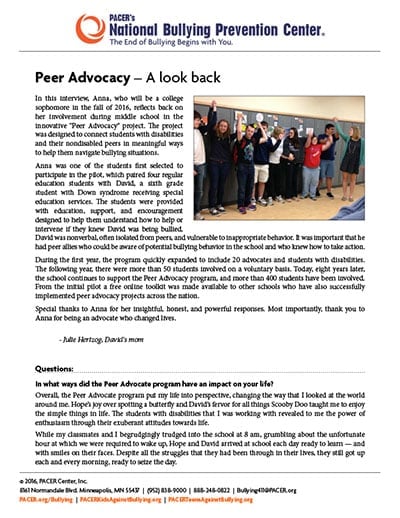
Interview on Peer Advocacy — A Look Back
In this interview, Anna, a college sophomore in the fall of 2016, reflects back on her involvement during middle school in the innovative “Peer Advocacy” project. The project was designed to connect students with disabilities and their nondisabled peers in meaningful ways to help them navigate bullying situations. Download the InterviewHow do I involve my school?
Encourage the adults in your school, such as your principal, school counselor, or teacher, to consider a “Peer Advocacy” project at school. DETERMINE THE PARTICIPANTS: In exploring a peer advocacy model in your school, consider who the adult leader should be, often it’s a teacher who has a relationship with students in the special education setting. Then, define which students with disabilities could benefit from peer intervention and inclusive practices. The next step is invite students to be peer advocates. When recruiting, its encouraged to look across the school environment and be sure to have representation from a diverse group of individuals. PROVIDE EDUCATION: The peer advocates should be educated on:- dynamics of bullying behavior
- characteristics, traits, and circumstances of the students for whom they are advocating
- options of how to intervene
- Peer Advocacy Guide Download the 32-page step-by-step booklet that looks at how to address bullying of students with disabilities by engaging, educating, and empowering their peers with advocacy skills.
- Peer Advocacy Pilot and Results
Peer Advocates Speak Out
In this 4-minute video, program participants from the Watertown-Mayer, Minn., school district share their experiences and viewpoints on their participation in the peer advocacy project.What else can students do?
Most important: Be a friend!
Watch out for those students, with and without disabilities, who might need your help and have their backs.
Tips to be a friend include:
- sit by them at lunch
- talk with them in the hallway
- include them in group activities
- invite them to spend time with you
- listen to their concerns
- provide advice and support
If you know that someone is being teased, hurt, or harmed in any manner, you can:
- get them away from the situation
- ask the person bullying to leave them alone (only if it feels safe to say something)
- let them know that everyone deserves to be safe
- let them know that they are important to you
- help them talk with an adult
- report it to an adult
Students who have been peer advocates said, “When I saw bullying happen, I…”
- took action, instead of just doing nothing
- told them to stop being so mean
- told someone that saying “that’s so retarded” hurts people with disabilities and is not acceptable
- stepped in and told them to stop
- privately told the person bullying that what they did wasn’t cool
- told our mentor, who helped me know what to do next time
- stood up for myself when it was me who was bullied
Students are talking!
Student advocates share:
“I learned that even though I am only one person I can change society.”
“Being a peer advocate makes me more aware when someone is not being included and it is a lot easier to include them and still have them feel comfortable. I have learned that there is so much more to me than just who I was before.”
“Before I saw people give the kids with disabilities bad looks and didn’t stand up for them, now I will stand up for them.”
“Before Peer Advocacy, kids were eating alone, now we are sitting with them and hanging out.”
“Peer advocates should spread around the world.”
“Later in life I’ll be able to say I was a peer advocate, I made a difference! Will you?”
“I love being a Peer Advocate, it’s so much fun. I love it and am happy I joined. Before it was not as fun being in nothing then I heard about Peer Advocates and then that inspired me and I did it for the kids with disabilities and they rock!”
“I think it’s important to be a Peer Advocate to let kids know they’re not alone and that others really do have their backs. Even though some treat them differently, they are just like everyone else. They should be treated the same, too. From this experience I learned all that. I think others should consider this too.”
What Should You Do? Peer Advocacy | PACERTalks About Bullying Episode 24
Insights and advice from students as they think through how to respond to real life bullying situations. In this video middle school students from a “peer advocacy” group explore how to handle a scenario in which a student with down syndrome is being bullied.
PACER’s Peer Advocacy Project | PACERTalks About Bullying, Episode 23
Get a behind the scenes look at the inspiration for the peer advocacy project, which connects students with and without disabilities.

How to Share Your Submission
Step One: As an individual or as a group, consider the question: What do you want everyone to know about bullying and disability?
Helpful prompts include:
- What is one thing everyone can do to help prevent bullying of students with disabilities?
- How have you, or someone you care about, been personally affected by bullying?
- What impact does kindness have on bullying prevention?
- Why are the qualities of acceptance and inclusion important?
- What is helpful for you when feeling isolated or alone?
- How does having a disability impact how you are treated?
Step Two: Create your response using the medium of your choice; such as video, artwork, photography, written stories, poetry, spoken word or other creative expressions.
Watch, read, or look at what others are sharing
Important Notes
- The goal of this series is to:
- educate about the intersection of bullying and disability
- inspire advocacy for self and others to prevent bullying
- build connections between individuals with and without disabilities
- When expressing perspective, be yourself!
- Don’t worry about “getting it right.” There are no wrong responses
- The responses can be from just you, or include a friend, family member, or several individuals
Send In Your Submission
Email your responses (video, artwork, photography, written stories, poetry, spoken word or other creative expressions) to [email protected]
Helpful Hints
- Hold the phone horizontal vs. vertical, which gives a wider screen
- Make sure you are close enough to phone to capture audio
- Props, such as signs with your written responses, are definitely an option
- NBPC can edit (or you can too!)
- NBPC will caption the files
Publications
A list of publications referenced.
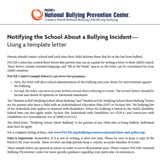
Students with Disabilities and Bullying: Top five things for parents, educators and students to know
This handout provides an overview of important facts for parents, educators and students to know about students with disabilities and bullying.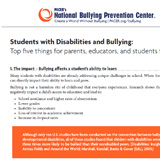
Bullying Prevention for Children with Disabilities: Using the IEP, 504, or Creating Your Own Plan
For students with disabilities, using an IEP, 504 Plan, or creating a personalized plan for bullying prevention with school professionals can help create a safer and healthier learning environment.
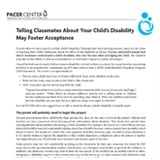
Notifying the School About Bullying – Using a Template Letter
Parents should contact school staff each time their child informs them that he or she has been bullied. PACER Center has created template letters that parents may use as a guide for writing a letter to their child’s school. These letters contain standard language and “fill in the blank” spaces so the letter can be customized for your child’s situation.- When the bullying is based on the child’s disability, federal laws can also apply under Section 504, Individuals with Disabilities Act (IDEA) and Americans with Disabilities Act Amendments Act of 2008 (ADAAA).
- Version for a Student with a 504 Plan (Word Doc )
- Version for a Student with an IEP Plan (Word Doc )
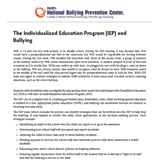
Use Positive Strategies to Protect Your Child with Disabilities from Bullying
While any child can be a target of bullying, children with disabilities can be especially vulnerable. Although few studies exist concerning children with disabilities and bullying in the United States, the studies available indicate an increased risk for children with special needs. Parents can help protect their children with disabilities from bullying and its devastating effects if they promote effective strategies such as PACER’s Peer Advocacy Program, use the Individualized Education Program (IEP) as a tool, work with the school, and know their child’s rights under the law.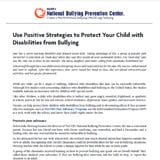
Telling Classmates About Your Child’s Disability May Foster Acceptance
One of the best ways to teach children about a disability is to talk to them at school. For many families, presenting at school is an annual event. Sometimes, an IEP team writes it into a child’s Individualized Education Program (IEP) document.

